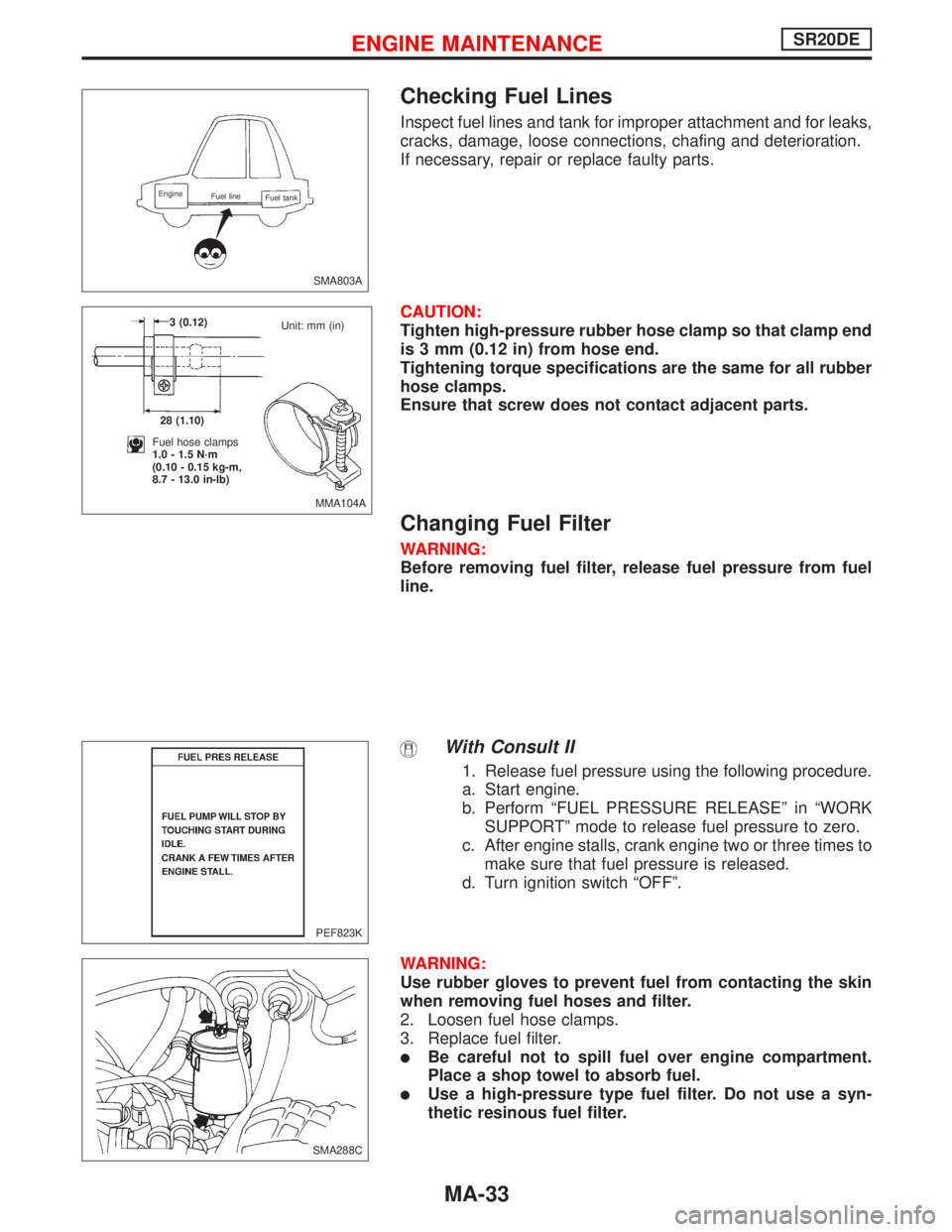Page 2050 of 2267

Checking Fuel Lines
Inspect fuel lines and tank for improper attachment and for leaks,
cracks, damage, loose connections, chafing and deterioration.
If necessary, repair or replace faulty parts.
CAUTION:
Tighten high-pressure rubber hose clamp so that clamp end
is 3 mm (0.12 in) from hose end.
Tightening torque specifications are the same for all rubber
hose clamps.
Ensure that screw does not contact adjacent parts.
Changing Fuel Filter
WARNING:
Before removing fuel filter, release fuel pressure from fuel
line.
With Consult II
1. Release fuel pressure using the following procedure.
a. Start engine.
b. Perform“FUEL PRESSURE RELEASE”in“WORK
SUPPORT”mode to release fuel pressure to zero.
c. After engine stalls, crank engine two or three times to
make sure that fuel pressure is released.
d. Turn ignition switch“OFF”.
WARNING:
Use rubber gloves to prevent fuel from contacting the skin
when removing fuel hoses and filter.
2. Loosen fuel hose clamps.
3. Replace fuel filter.
�Be careful not to spill fuel over engine compartment.
Place a shop towel to absorb fuel.
�Use a high-pressure type fuel filter. Do not use a syn-
thetic resinous fuel filter.
SMA803A
Engine
Fuel line
Fuel tank
MMA104A 3 (0.12)
28 (1.10)
Fuel hose clamps
1.0 - 1.5 N·m
(0.10 - 0.15 kg-m,
8.7 - 13.0 in-lb)Unit: mm (in)
PEF823K
.SMA288C
ENGINE MAINTENANCESR20DE
MA-33
Page 2060 of 2267
Pull the negative-pressure valve to open it. Check that it closes
completely when released.
CHECKING COOLING SYSTEM FOR LEAKS
Apply pressure to the cooling system with cap tester to check for
leakage.
Testing pressure:
157 kPa (1.57 bar, 1.6 kg/cm
2, 23 psi)
CAUTION:
Higher pressure than the specified value may cause damage
to radiator.
Checking Fuel Lines
Inspect fuel lines and tank for improper attachment and for leaks,
cracks, damage, loose connections, chafing and deterioration.
If necessary, repair or replace faulty parts.
Checking and Replacing Fuel Filter and
Draining Water
CHECKING FUEL FILTER
Check fuel filter for fuel leakage, damage and other abnormal
signs.
REPLACING FUEL FILTER
1. Disconnect fuel filter sensor connector and drain fuel.
SMA871B
SMA990A Hose adapter
EG17650301
SMA803A
Engine
Fuel line
Fuel tank
SMA794C Loosen
Drain valve
ENGINE MAINTENANCECD20T
Checking Cooling System (Cont’d)
MA-43
Page 2064 of 2267
5. Check initial injection pressure by pumping tester handle
slowly (one time per second).
Injection pressure:
12,749 kPa (127.5 bar, 130 kg/cm
2, 1,849 psi)
�Always check initial injection pressure before installing
new nozzle.
6. Check fuel spray pattern by pumping tester handle quickly (4
or 6 times per second).
a. If main spray angle is within 30 degrees as shown, injec-
tion nozzle is good.
b. It is still normal even if a thin stream of spray deviates
from main spray (pattern B).
7. If spray is not correct, clean injection nozzle tip or replace it.
Refer to EC section for injection pressure adjustment, clean-
ing and replacement.
8. Install all injection nozzles with S.S.T. KV119E0030 and
securely connect fuel spill hoses and delivery tubes.
9. Bleed air from fuel system and check for fuel leakage with
engine running.
Replacing Timing Belt
Refer to“TIMING BELT”in EM section.
SEF672A
SEF079S
ENGINE MAINTENANCECD20T
Checking Injection Nozzles (Cont’d)
MA-47